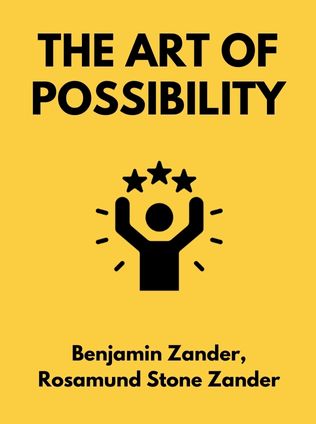
The Art of Possibility
Transforming Professional and Personal Life
By Benjamin Zander, Rosamund Stone Zander
Published 09/2002
About the Author
Rosamund Stone Zander is an executive coach and family systems therapist renowned for her work in leadership, relationships, and effective action. She has conducted workshops and developed programs for numerous organizations, including the British Civil Service, the Aspen Institute, and National Public Radio. Her innovative models promote creativity as a fundamental adult capacity.
Benjamin Zander is the conductor of the Boston Philharmonic Orchestra and has been a prominent figure in the world of music for over three decades. He regularly performs with top orchestras worldwide and has recorded complete cycles of Beethoven and Mahler symphonies with the Philharmonia Orchestra of London. Zander also speaks extensively on leadership and creativity, sharing his insights with major organizations globally.
Main Idea
The core concept of The Art of Possibility is the transformative power of shifting perspectives to unlock creativity and innovation. The Zanders argue that changing one's outlook from a mindset of scarcity to one of abundance can open up limitless possibilities in both personal and professional life. By rethinking assumptions and embracing new ways of seeing the world, individuals and organizations can achieve greater success and fulfillment.
Table of Contents
- Reclaiming Our Creativity
- The Five Competencies of Creative Intelligence
- Indie Capitalism
- What’s Your CQ?
- Rethinking Creativity
Reclaiming Our Creativity
In the initial part of the book, the Zanders emphasize that everyone has the potential to be creative. They share the story of Keith Richards and Mick Jagger to illustrate that creativity often results from collaboration and years of dedication rather than sudden genius. This section highlights the importance of shifting our perspective on creativity from an individualistic endeavor to a collaborative process.
"This is not just that he's fantastic and the rest are crap; they're all interconnected." - Keith Richards
The Zanders argue that the search for creativity involves looking beyond the individual and recognizing the interconnectedness of ideas and experiences. They believe that the modern education system often stifles creativity by emphasizing rote memorization over exploration and play. By reclaiming our innate creativity, we can foster a more innovative and adaptable society.
Rosamund Stone Zander’s perspective on creativity as an essential adult capacity is crucial for developing leadership and relationship skills. Her work with various organizations shows the applicability of creativity in diverse contexts, from corporate settings to educational institutions.
The Five Competencies of Creative Intelligence
The Zanders introduce five competencies essential for developing Creative Intelligence:
- Knowledge Mining: Leveraging personal experiences and cultural insights to inspire innovation.
- Framing: Shifting perspectives to understand and solve problems in new ways.
- Playing: Embracing playfulness as a method for exploring possibilities and fostering creativity.
- Making: Engaging in the physical creation of products to bring ideas to life.
- Pivoting: Adapting and transforming ideas into actionable and impactful innovations.
Knowledge Mining
Knowledge mining involves extracting valuable insights from personal experiences and cultural contexts. The Zanders illustrate this with the example of Steve Jobs, who combined his diverse interests and experiences to create groundbreaking products.
"Serendipity affects how and when we connect different ideas to produce new ones." - Bruce Nussbaum
Several types of knowledge mining are described, including:
- Embodiment: Using personal and cultural knowledge intuitively to create new solutions.
- Immersion: Engaging deeply with new cultures and experiences to gain fresh perspectives.
- Connecting dots: Identifying and linking seemingly unrelated knowledge to spark innovation.
- Donut Knowledge: Recognizing what is missing and using that gap to drive creativity.
- Dreams, Not Needs: Focusing on aspirations and desires rather than mere necessities to inspire innovation.
These strategies enable individuals to tap into their unique experiences and insights, leading to the creation of novel and impactful ideas. By understanding and applying these forms of knowledge mining, people can enhance their creative abilities and contribute to innovative solutions in various fields.
Framing
Framing involves viewing problems and opportunities from different angles to uncover new solutions. The Zanders explain how altering our mental frames can lead to breakthroughs in understanding and innovation.
"Reframing is about breaking routine." - Bruce Nussbaum
They identify three key types of framing:
- Narrative Framing: Changing the stories we tell ourselves to shift our perspectives and open up new possibilities.
- Engagement Framing: Understanding and rethinking our interactions to create deeper and more meaningful connections.
- What-If Framing: Challenging our assumptions and envisioning alternative scenarios to drive innovation.
By mastering these framing techniques, individuals can break free from conventional thinking patterns and approach problems with a fresh perspective. This ability to reframe situations is crucial for creativity and can lead to significant breakthroughs in various domains.
Playing
Play is a powerful tool for creativity, allowing individuals to experiment and discover new possibilities. The Zanders emphasize the importance of play in both personal and professional contexts.
"Play triggers competition and cooperation, tenacity and joy." - Bruce Nussbaum
Several ways in which play can enhance creativity are outlined:
Sign up for FREE and get access to 1,400+ books summaries.
You May Also Like
The Subtle Art of Not Giving a F*ck
A Counterintuitive Approach to Living a Good Life
By Mark MansonRich Dad Poor Dad
What the Rich Teach Their Kids About Money - That the Poor and Middle Class Do Not!
By Robert T. KiyosakiHow To Win Friends and Influence People
The All-Time Classic Manual Of People Skills
By Dale CarnegieQuiet: The Power of Introverts
The Power of Introverts in a World That Can't Stop Talking
By Susan Cain



















